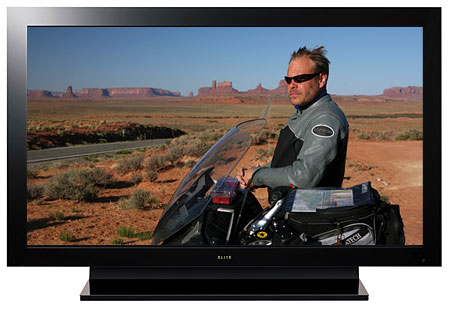Pioneer Elite PRO-101FD Plasma Monitor

In addition to Pioneer- and Elite-branded plasma TVs, the 9G lineup also includes two Elite Kuro Signature Series monitors, such as the 50-inch PRO-101FD reviewed here, that have no built-in audio or tuner. These monitors are said to be the best of the best, with more adjustability and better performance than ever before. The intended market is high-end custom installation, which is clearly reflected in the $4500 price tag. At that level, buyers will surely have a good outboard surround-sound system and a TV source such as cable or satellite, rendering these functions unnecessary in the display itself. (Note: the monitors also do not come with a table-top stand, which can be purchased separately.)
It's important to note that 9G is the last generation that will be manufactured entirely by Pioneer. Subsequent plasma glass will be supplied by Panasonic, though Pioneer will continue to manufacture the final product, incorporating all of the company's proprietary processing and other enhancements.
Given all of that, I was eager to put the monitor through its paces. Does it measure up to its considerable reputation? Without question.
Features
As promised, the PRO-101FD provides a panoply of features, though there are a few from the PRO-111FD that are missing here, such as Home Media Gallery, which lets the set access media content on networked computers and DLNA (Digital Living Network Alliance) servers. The PRO-101FD does have an Ethernet port, which can be used to calibrate and control the TV from any web browser, including those on mobile devices, in a custom-installed situation.
Like virtually all modern displays, this one offers several preset modes—called AV modes in Pioneer-speak—including an Optimum Mode that automatically adjusts many parameters based on the image content and ambient-light conditions. I much prefer to leave all that automatic felgercarb off and manually adjust the TV for optimum performance, which is best done in the Pure AV mode.
One big improvement over all previous models is that many of the picture controls are associated with the inputs, not the AV modes, which means you can adjust, say, the Pure mode differently for each input. Even better, these settings are independent for each signal resolution and frame rate. This is supremely flexible, but it's a bit of a pain to have to re-enter all your settings for 1080i, 1080p/60, and 1080p/24, not to mention 720p, 480p, and 480i. I wish there was a copy function for all the user controls, which would make it fast and easy to copy the settings for one input or resolution to another that you could then tweak as needed.
All Pioneer Kuro TVs and monitors have the ability to display 1080p/24 at 72Hz, repeating each frame three times. This avoids 3:2 pulldown altogether and results in much smoother motion on film-based material. I know of no other flat panels with this rare and important feature.
Also available are three deinterlacing modes for 480i and 1080i signals. Standard mode reassembles the original film frames and displays them in a 3:2 cadence at 60Hz (a procedure called "inverse telecine"), while Advance mode does the same thing but displays each frame three times at a display rate of 72Hz, avoiding 3:2 pulldown. Smooth mode reassembles the original film frames and interpolates new frames between them as needed to achieve a display rate of 60Hz.
A color-management system (CMS) allows those with the requisite training and tools to move the color points around, though it's not really needed in the Pure mode—the color points are very close to correct in this mode (see Measurements). Still, I couldn't help trying to get them even closer. Unfortunately, the CMS provides only a tint control for each color; missing are saturation and brightness controls. This is surprising for a high-end monitor that is touted to provide the ultimate in controllability.
Unique to the Elite line—including the Signature Series monitors—are ISF Day and Night modes, which can be calibrated only from the service menu or by using special software developed by Sencore. These modes let a calibrator lock in the calibration so they can't be messed up by inveterate but unskilled tweakers.
With HDMI 1.3 inputs, the PRO-101FD supports Deep Color (increased color bit depth), x.v.Color (expanded color gamut), and CEC (Consumer Electronics Control), which Pioneer calls Kuro Link. Deep Color and x.v.Color are not used in any commercial content, though some HD camcorders use them. CEC allows compatible devices connected with HDMI to communicate with each other, sending and receiving command codes for integrated system control.













































